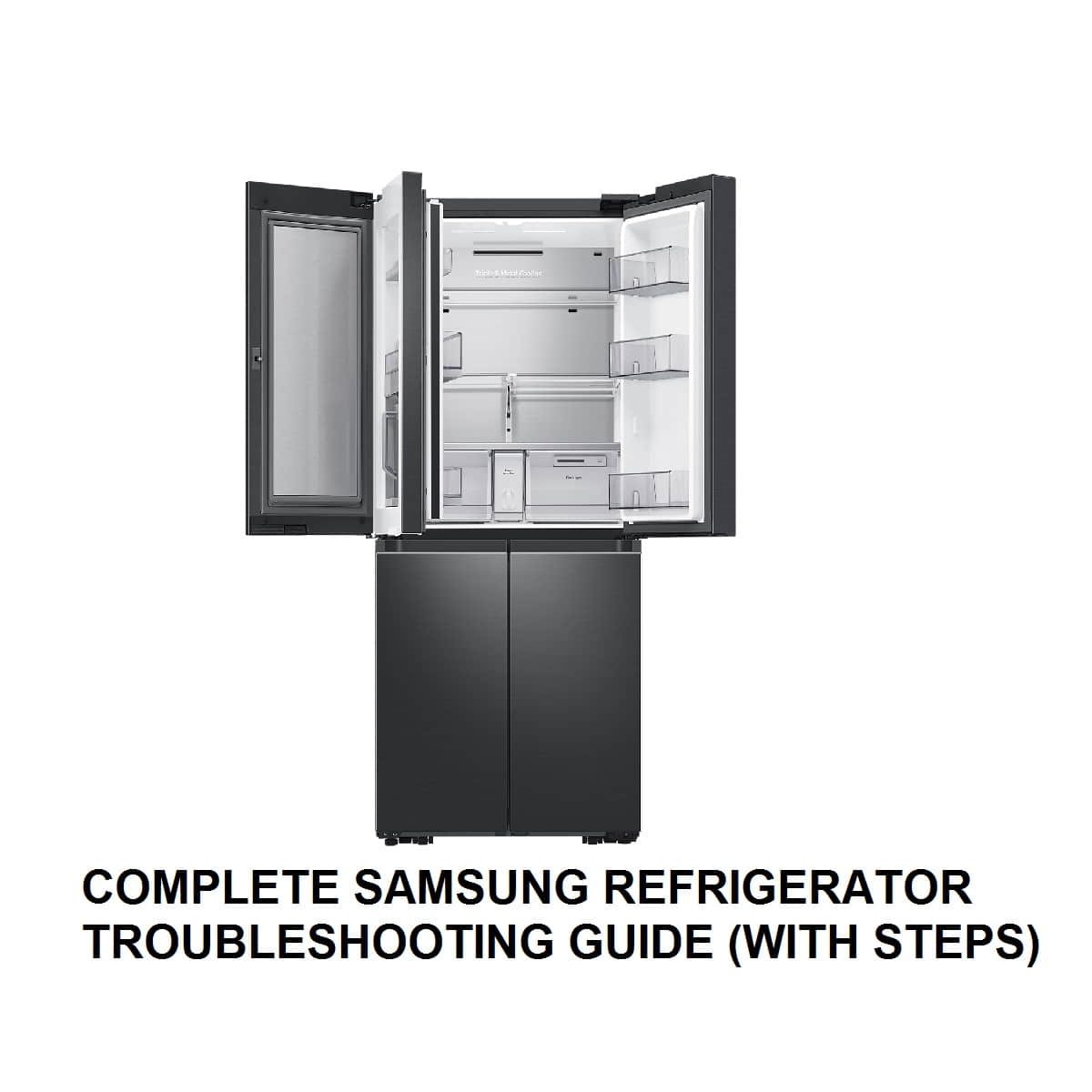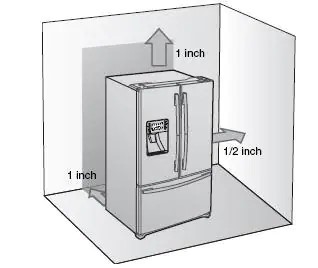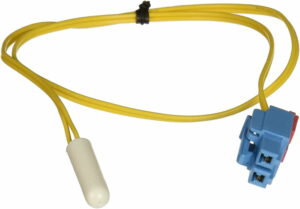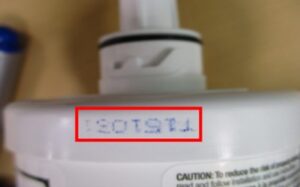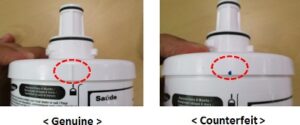As an Amazon affiliate, we earn a commision from qualifying purchases.
Here is a detailed Samsung refrigerator troubleshooting manual to help you fix your Samsung fridge problems
If your Samsung refrigerator is acting up, then, you are in the right place.
This Samsung refrigerator troubleshooting manual will guide you on how to go about fixing most Samsung refrigerator issues.
So read on to find out how to fix your Samsung refrigerator issues.
Samsung refrigerator troubleshooting manual – troubleshooting your Samsung refrigerator
Since there is no one-size-fits-all solution, we shall look at the troubleshooting steps individually.
Samsung refrigerator won’t turn on / Samsung refrigerator not turning on
The first step you should take when fixing a Samsung refrigerator that won’t turn on is confirming that your fridge is properly plugged in.
That’s because your pet or kid might have tugged at the power cord and pulled it loose.
And while at it, be sure to confirm that the power outlet is working-You can test this by plugging in another appliance (such as an electric kettle).
Now, if the power outlet is faulty, it is advisable to have an electrician look at it.
Next, check your mains to confirm that the circuit breaker is not tripped.
If it is, you will need to reset it.
Samsung refrigerator won’t stop beeping
Generally, Samsung refrigerators beep as an indication that you have left the door open or it isn’t closed properly.
So be sure to start there.
Of course, if the door is closed, you will need to open it and confirm that no object is preventing the door from closing.
And while at it, confirm that you have not overstocked your fridge- overloading it with foodstuff could be preventing the door from fully closing.
Alternative fixes
Confirm that the door seals are not dirty.
We actually recommend that you clean them – just use a mild detergent and a damp cloth and finish by wiping the seals dry using a dry cloth.
And while there, confirm that the door seals are not damaged.
If they are, you will need to replace them.
Luckily, you can get OEM Samsung fridge door seals at Amazon- Just be sure to get one designed for your model.
Quick tip:
You can test if the door seals are faulty by placing a thin sheet of paper between the door and the refrigerator and then close your door.
You then pull at your paper- If you can pull it out without any resistance, it is an indication that the door is not closing properly.
Additional step: Test the reed switch
Finally, it could be that your reed switch is faulty.
Now, to test this switch, you will need a magnet.
Note:
For a French door refrigerator, the switches are located beneath the two arrows on the top cover.
Consequently, you will need two magnets to test the switches in a French door-type fridge.
To do this, place one magnet on one switch and slide the other magnet across the other switch.
On the other hand, if you have a single-door fridge, simply drag your magnet across the reed switch.
If the light turns off, it means that your switch is working fine.
In contrast, if the light does not turn off, it might mean that the switch is faulty so you might have to get a Samsung reed switch replacement.
Samsung refrigerator won’t cool / Samsung refrigerator not cooling / Samsung refrigerator stopped cooling / Samsung refrigerator problems not cooling / Samsung refrigerator not cooling but freezer is fine
To begin with when it comes to cooling problems, is your fridge getting power?
Go back to the first section (Samsung refrigerator won’t turn on) -it should help you verify that it has a stable power connection.
Moving on……
Confirm that the door is closing properly.
That’s because failure to do so typically cause the cold air to leak out.
For this fault, refer to the previous section (Samsung refrigerator won’t stop beeping)- we already talked about how to fix it..
Again don’t forget to check and confirm that you haven’t overstocked your fridge- we already saw that overpacking it could result in foodstuff blocking the air vents, thereby impeding the airflow.
Next, you will need to lower the temperature settings of your fridge to the ideal settings.
To be clear, these settings are 3°C (37°) and -18°C (0°F) for the refrigerator and Freezer respectively.
Alternative repairs
If your refrigerator is located in direct sunlight or it is near a heat source, you may need to relocate the fridge.
That’s because the heat usually impedes the cooling system of the refrigerator.
Additionally, you will need to check the distancing of your refrigerator from the wall.
Keep in mind that the minimum clearance required between the refrigerator and the wall is as shown below:
So confirm that you are adhering to these dimensions.
Finally
Confirm that your fridge is not in demo mode (Cooling Off mode) – it could be that you accidentally turned this mode on or you have a brand-new fridge.
You can easily know if your fridge is in demo mode if the display shows any of the following codes:
- OF OF
- O FF
- OFF OFF
- Temperature bars scroll back and forth.
- With regard to Family Hub models, all compartments display OFF in the Fridge Manager.
Now, turning off this mode varies from model to model.
That being so, you can refer to Samsung’s chart on how to turn demo mode off depending on your model.
Locate your model and follow the instructions to turn off demo mode.
Samsung refrigerator troubleshooting manual – how to fix more problems
Samsung fridge not cooling but light is on
When this happens, you’re certain that power is not the cause of the problem.
What you need to know is that the steps you need to fix it are similar to the other steps we have just tackled above (Samsung fridge not cooling) so go back above and try them to fix your unit.
Samsung refrigerator not freezing / Samsung refrigerator stopped freezing / Samsung refrigerator problems freezing up
To begin with, most of the fixes for your freezer not freezing are again similar to the ones we have discussed above (Samsung refrigerator not cooling) so follow the indicated troubleshooting steps.
By the way, how full is your freezer?
At times, the freezer may stop freezing if it fails to detect any foodstuff.
Keep in mind that Samsung recommends that you have your freezer stocked between ½ and ¾ way.
More fixes
#1- Check the condenser coils
Are they dirty?
If they are, you will need to wipe them clean- all you will need here is a rag.
#2-Additional fix
If none of the above works, you will need to power cycle your unit.
Here’s how to do it…
Unplug the unit and let it sit for five minutes.
Plugging the unit back should reset it and freezing should resume within two hours.
Samsung refrigerator not cooling or freezing / Samsung refrigerator stopped cooling and freezing
The troubleshooting steps for fixing this are similar to the ones we have just covered above on Samsung refrigerator not cooling and Samsung fridge not freezing section so try them and see how it goes.
Samsung refrigerator won’t dispense water / Samsung refrigerator not dispensing water / Samsung refrigerator stopped dispensing water
The first and easiest fix is to check and confirm that the water line is indeed connected.
Also, confirm that you have the shut-off valve opened.
Meanwhile, check along the length of the water supply line to make sure that it is not kinked or crushed.
If it is, try to straighten it out.
Finally, you will need to inspect the water tank and confirm that it is not frozen – it might get frozen by extremely low fridge temperatures.
If this tank is frozen, you will need to adjust the refrigerator temperatures – select a slightly warmer temperature but before that, be sure to defrost your unit.
Samsung refrigerator won’t dispense ice / Samsung refrigerator not dispensing ice / Samsung refrigerator stopped dispensing ice
To begin with, have you confirmed that you did not manually stop the ice making function?
To know how to go about this, read our other article on troubleshooting Samsung ice maker.
Next, confirm that the water line is indeed connected and that the shut-off valve is opened.
Don’t forget that if you have recently installed the water supply line, you could need to wait for around 12 hours after the installation before making ice.
Otherwise, your fridge won’t produce nor dispense ice.
Finally, consider checking your set freezer temperature-It could be that it is too warm.
If that is true, you may have to select a lower freezer temperature.
Samsung refrigerator troubleshooting manual -Samsung refrigerator problems with ice maker
There are two main problems that you may specifically experience with your ice maker.
First, your ice maker may not be producing enough ice or you may have an ice maker that is not producing any ice at all.
So let us see how to fix your Samsung fridge ice maker when it is acting up…
Samsung refrigerator not making enough ice
Now, if you do not regularly dispense your ice, it will pile up beneath the ice maker and this will prevent further ice production.
Therefore, be sure to regularly shift the ice in the bucket forward.
Quick Tip: If ice piles up on one end of the ice bucket, the ice maker may assume that it is full hence thereby stopping ice production.
Also, confirm that the door(s) is always closed.
Opening the door will not only pause ice production but it will also allow warm air to enter your fridge – this means it will take longer for the ice maker to freeze the ice.
Confirm that there is enough water pressure
Now, if your fridge model has a water line, confirm that the water line has enough pressure to fill six ounces (3/4 cup) in less than ten seconds.
If it lacks sufficient pressure, you can either use a measuring cup to dispense water or just increase the water pressure.
Important: This pressure is not controlled by the refrigerator so you will need to adjust it at the source.
To adjust the pressure, make sure that the water supply valve is fully open.
Alternatively, you may have a plumber increase the pressure to 20 psi (recommended pressure by Samsung).
Check if the water filter needs to be replaced
Fact: Water filters are rated for 300 gallons of usage- this , on average, equates to around 6 months of usage in an average household.
So if it has been a while since you last replaced the filter, first remove the filter and see if the ice production issue is resolved.
If this fixes the issue, it could mean you have a faulty water filter.
Subsequently, you might have to get a replacement filter. We recommend a genuine OEM water filter from Samsung.
Check the leveling too
Is your refrigerator leveled as it should be?
You can read Samsung’s refrigerator levelling guide to confirm you have it the right way.
If not, level the unit properly.
Samsung refrigerator not producing ice / Samsung refrigerator stopped making ice / Samsung fridge stopped making ice / Samsung refrigerator won’t make ice / Samsung refrigerator not making ice
If it won’t make ice anymore, start by checking if there is any ice blocked in the ice passage-This ice could be blocking other ice cubes from being dispensed.
Now, to clear the blockage, you can run warm water through the ice bucket opening.
Next, you will need to test the water pressure – it should be at 20 psi.
If it is below this, you will need to increase it.
Is the ice maker turned on?
Most models have an Ice Off icon which turns the ice maker on and off and the appliance won’t make ice if its off.
To know if the ice maker is on, simply look at the icon and confirm that it is not lit.
Now, turning this on and off will vary from model to model.
Quick Tip: Some models have an Ice On icon instead. When this icon is lit, it means that the ice maker is turned on.
Moving on, on Family Hub models, you can control this function in the Fridge Manager App.
Turning to top freezer models, you be sure to confirm that the Ice On icon is lit. If it is not, simply touch it to start your ice maker.
And if your model has dual ice makers, it will have an Ice Off icon for each ice maker.
However, only one button controls them both.
Now, to turn on the ice makers, continuously tap on this button until neither of the icons is lit.
Lastly, on all other models, simply tap the words below the Ice Off icon to toggle the ice maker on and off.
This icon should be dim when the maker is off and vice versa.
Reset the ice maker
Samsung ice makers normally come with a test button and we shall be using this button to reset the ice maker.
Quick Tip: On most models, you will need to remove the ice bucket to view the ice maker.
Now, first locate the test button on your ice maker.
Once you do so, follow these steps to reset the ice maker:
- Press and hold the test button until you hear a chime. This may take up to 10 seconds.
- If you had removed the ice bucket, you will need to re-insert it after the chime. Your ice maker will now run a test cycle which will take around six minutes. During this test cycle, you might hear ice dropping into the bucket and the water valve energizing as it fills the ice maker.
- Once the test is done, you will hear another chime indicating that the ice maker has been reset.
Confirm that your water lines are not cross-connected (only for RS22T and RS27T models)
If these water lines are cross-connected, then the water and ice-dispensing functions will not work as they should.
Therefore, if you own one of these models (and the dispenser has not been working since installation), you will need to check the water lines and connect them properly.
Alternative fixes
You will need to check that your water line has enough pressure to dispense six ounces in less than 10 seconds.
As mentioned earlier, you will also need to check if the water filter needs replacing while at it.
Now, to achieve both of these steps, simply refer to the two easy-to-follow steps we have just seen above when fixing an ice maker that is not dispensing enough ice.
Power cycle the refrigerator
In some cases, it is usually just an electrical glitch.
To fix the unit, all you will need to do is power cycle the unit by unplugging it for five minutes.
Plugging the fridge back should fix it.
What next?
After you perform the above steps, ice production should begin within eight hours.
Nonetheless, it may take up to 24 hours for the ice production to fully return to normal.
Samsung refrigerator won’t roll
To begin with, it is important to note that not all models have wheels.
With that in mind, first confirm that your model has wheels.
You can do this by carefully looking at the bottom and if the unit has wheels, you should see them.
Alternatively, you can also confirm from your user manual.
Now, on some models, you will need to adjust the front legs of your refrigerator until they come into contact with the floor.
Once they have locked into position, you can proceed to move the unit.
Nonetheless, if your refrigerator has been sitting in the same spot for quite a long time, it will need a little extra effort to move it.
Samsung refrigerator troubleshooting manual – repairing further faults
Samsung refrigerator won’t run on generator
First, you will need to know how much power (watts and amps) your fridge requires.
If you are unsure how much power it requires, you can find this information on the inside left wall of the fridge compartment where the model code is located.
Tip: if the amps are not indicated, you can calculate them by using the equation:
Watts / volts = amps
Now, you will need a generator that can produce enough power in watts as the one indicated in your fridge.
Also, be sure that you are using an electrical cord rated for the amps required by your refrigerator.
If you are using the right generator and cord but the fridge still won’t work, chances are that you have other devices connected to the same refrigerator.
Consequently, you will need to disconnect them to be sure that it is not a case of overloading.
Samsung refrigerator won’t connect to wifi / Samsung refrigerator not connecting to wifi
To fix Wi-Fi connectivity issues, begin by confirming that your Wi-Fi network is turned on and discoverable.
Next, you will need to navigate to Settings > Connections > Wi-Fi on your fridge.
If it is the first time connecting your fridge to this network, tap on the Show password setting just to confirm that you have not accidentally hit an incorrect character.
Remember to confirm that your router password has not been changed recently.
Next, you will need to disconnect some devices from your Wi-Fi network and then try and reconnect the fridge.
That’s because your network might be full and will need some devices to be disconnected before it allows a new connection.
Alternative fixes
Check the signal strength of your network – it might be too weak for the refrigerator to connect to.
To check the signal strength, first connect your phone to the Wi-Fi network.
Next, hold the phone next to the fridge and check the signal strength.
If it is one bar or it does not appear on your phone altogether, it signals that the signal is weak.
Consequently, you should move the refrigerator and router closer to each other.
Alternatively, you can use a repeater to boost your router’s signal strength.
Reboot the wi-fi router/modem
The final fix you will need to try is rebooting the Wi-Fi router/modem.
This is worth trying since at times the problem is not with the refrigerator but with the router.
Samsung refrigerator won’t defrost / Samsung refrigerator not defrosting
There are several reasons why your Samsung refrigerator is not defrosting.
And as you might have guessed, each of these methods has its own fix.
To begin with, you might be having a faulty temperature sensor.
Consequently, you will need to first test it.
If you are unsure what a temperature sensor looks like, it should look like the one below:
Start by carefully inspecting the sensor for any signs of corrosion, cracks or breaks in the wire.
If you can spot any, then, your temperature sensor is faulty and you will need to replace it.
Next, you will test the sensor using a multimeter that can measure at least 20,000 ohms.
We recommend that you test at two different levels preferably at room temperature and in a glass of ice water.
Quick Tip: if you have an auto-ranging multimeter, turn it to the ohm setting while for a manual multimeter, turn it to 20K or 40K setting.
For test one, touch the probes to the two wires of the sensor.
Turning to test two, insert the sensor into a glass of ice water and let it sit there for around ten minutes so that it cools down.
You can now touch the probes to the sensor wires.
Now, you should check your readings to see if they match Samsung’s recommended readings as you can see from the chart below:
If your readings are not within these ranges, it could mean that your temperature sensor is faulty and you will need to get an OEM temperature sensor.
For additional fixes, read our other article on how to fix Samsung refrigerator defrost problem.
Samsung refrigerator stopped working / Samsung refrigerator stopped running / Samsung fridge stopped working
If it stopped working at all, you might be having a faulty overload relay/relay-start capacitor so testing it is the first logical thing to do.
To test it, you will use a multimeter to test for continuity.
If it lacks continuity, it is faulty and as such, you will need to get a replacement start capacitor.
Alternative fix
Most modern refrigerators are equipped and controlled by electronic control boards.
Despite that, it could be that your control board has gone bad.
To test it, you will need to remove it from your fridge and follow this by visually inspecting it for signs of burnt connections, arcing or any other damages.
That is because electronic control boards cannot be tested by simply using a multimeter.
Instead, an more sure way is to rely on visual observation.
If you can identify any fault on the board, it means that it is faulty and you will need to get an OEM refrigerator control board replacement.
Samsung refrigerator troubleshooting manual – how to fix leaks
Water leaks in Samsung refrigerator / Samsung refrigerator problems water leaking
To make troubleshooting water leaks easier, we shall look at how troubleshoot the leakage depending on where the water is oozing from…
Samsung refrigerator leaks water from the front
To begin with, is your refrigerator leveled as it should be?
In some models, the front should be slightly higher than the back – enables the coolant to drain with ease.
Therefore, if your refrigerator is leaking from the front, it means that it is not properly leveled.
Consequently, you will need to level it properly.
You can quickly check if your refrigerator is leveled by looking under the front.
If the wheels are still touching the floor, then, the refrigerator is still not high enough.
Samsung refrigerator leaking inside / Samsung refrigerator water freezes inside
In this case, chances are that the defrost drain is clogged.
It might be clogged by food particles or other debris and this may result in water leaking inside your unit and in some cases, this water may freeze over.
Locate the defrost drain inside your freezer (at the back). It is a small hole located at the bottom of the freezer.
On occasions, it can be hidden behind a plastic or metal panel which you can easily remove by unscrewing.
With being said, check the defrost drain for any clogs and if it is indeed clogged, be sure to clean it.
Samsung refrigerator leaks from the bottom
This could be an indication that the drain tray is overflowing.
As such, you will need to inspect the drain tray to see if it is filled with water.
If it is, it means that automatic evaporation of the water has failed.
To fix this, you will need to turn off your refrigerator and clean your drain tray – chances are that it is dirty from food debris, dust and other clogs.
Note: If the humidity is more than 75% or the ambient temp is significantly lower than 25⁰C (77⁰F), auto-evaporation may be affected adversely.
Samsung refrigerator leaks from the back (for models with a water inlet connection)
When this occurs, it is an indication that something is wrong with the water inlet connection. The connection could either be loose or damaged.
That being so, you will need to inspect the connection at the back of your refrigerator.
If it is loose, be sure to tighten it. On the hand, if it is damaged, you will need to replace it.
Samsung refrigerator leaking from the water filter
Here you may need to remove the water filter and check it for signs of damage.
Also be sure to inspect the filter housing for any damages.
If the filter is damaged, replacing it should stop the leakage.
I recently replaced my water filter but my refrigerator is still leaking from the water filter. What next?
If this is you, chances are that you did not get a genuine water filter and that is why it is acting up.
Fact: Samsung recommends using genuine water filters.
There are two ways you can identify if you have a genuine filter or not. They are:
- Genuine Samsung water filters will have a serial number on their body as shown:
- Genuine Samsung water filters will have a rib on the filter body as you can see below:
So confirm that you are using a genuine Samsung water filter – order an OEM water filter if not.
Samsung refrigerator troubleshooting manual – repairing fan noise issues
Samsung refrigerator fan hitting ice / Samsung refrigerator fan noise / Samsung refrigerator problems fan noise
For the most part, you will note that the noise will tend to stop once you open the refrigerator’s door.
Now, this noise is caused by the buildup of ice around the fan.
Recommended solution
Now, to fix this, you will need to first perform a manual defrost.
Nonetheless, this is not a permanent solution.
For a detailed and permanent solution, read our other article on Samsung refrigerator fan noise ice buildup fix.
Samsung refrigerator temperature problems
Now, if your refrigerator’s temperature is acting up, the best solution is to reset it.
However, it might not be as easy as it sounds.
That is why we have dedicated a whole article on fixing this so read how to fix Samsung refrigerator temperature problems.
ALSO READ: Samsung fridge flashing temp
Samsung refrigerator troubleshooting manual -FAQs
What is the most common problem with Samsung refrigerators?
According to a report by the Consumer Product Safety Commission, the most common issue with Samsung refrigerators is problems maintaining appropriate temperatures and malfunctioning ice makers.
You can read the full article on Yahoo News.
Samsung refrigerator troubleshooting manual – final words
There goes our comprehensive Samsung refrigerator troubleshooting manual – we are sure you now have an idea about what to do to make your fridge to function normally again
Just two extra points before we wind up:
If you are unsure of how to go about a certain step, we recommend that you get an instructional video on YouTube to guide you.
Also, when replacing your Samsung refrigerator parts, it is always best to get OEM parts because they outlast generic parts.

